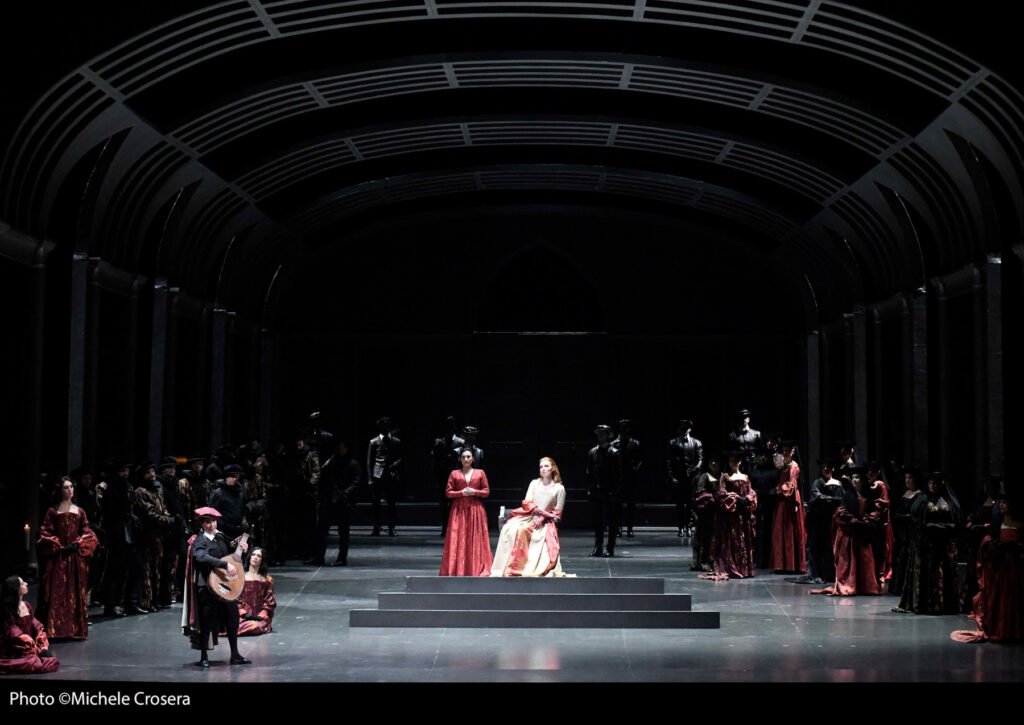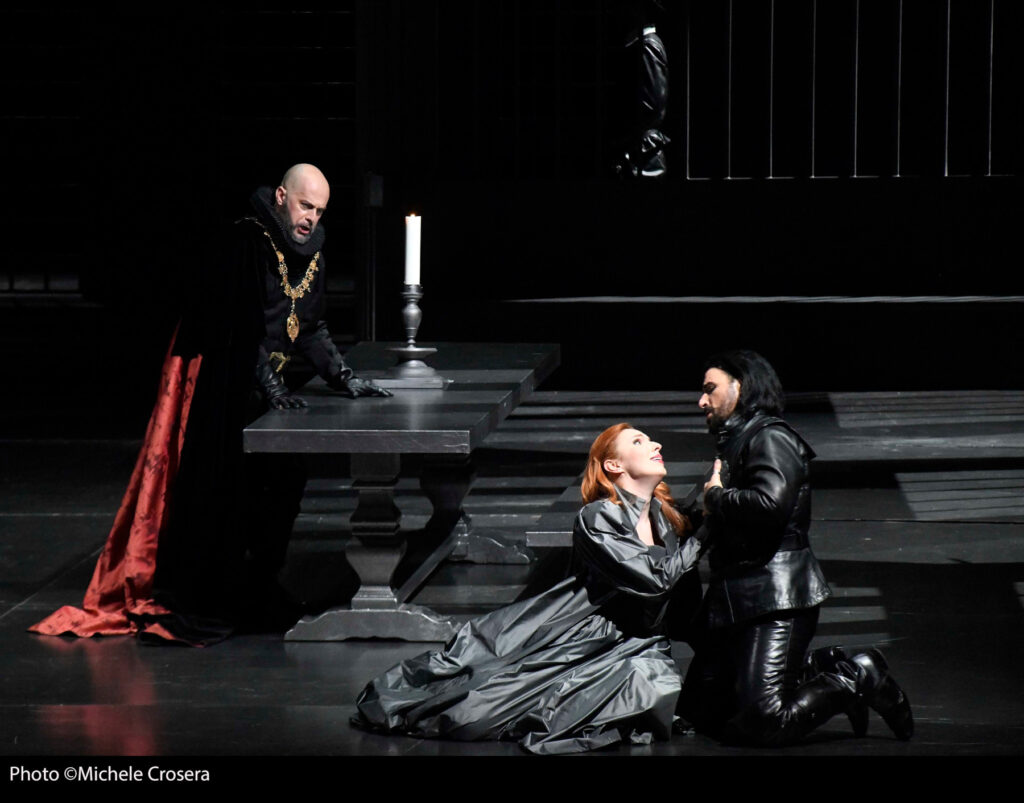Donizetti’s Anna Bolena regained a place on the operatic stage since at least the rediscovery of bel canto repertoire after the Second World War, through the advocacy of singers such as Maria Callas, most notably. But curiously it has not been seen at Venice’s La Fenice since 1857, even though it was mounted there twice within just a handful of years after its premiere at Milan in December 1830.
Director Pier Luigi Pizzi refers approvingly to Luchino Visconti’s celebrated La Scala production of the 1950s, in which Callas appeared. But here he prefers a more pared down setting (though he says not minimalist): the time and place of Tudor England is evoked generally in a simplified late Gothic hall, and in costumes which adapt the style of that era. The prevailing dark colours and sullen atmosphere of the set effectively become the production’s central idea, as well as the strikingly (even alarmingly) sloping stage, aligning with the doom-laden thrust of the drama which ends in tragedy for at least three of the characters. In the austere costume designs here, one wonders whether there is also a nod to the custom of the nobility to wear similarly restrained black dress in the historic republic of Venice.

That hall is shadowy and oppressive for Act One (nominally at Windsor Castle) but it becomes explicitly so in the second, when bars appear in the windows and screens to form a prison (the Tower of London in the original scenario) with plain refectory tables. If that sparseness potentially risks losing dramatic impetus, it successfully realises Pizzi’s aim in focusing attention on the emotional life of the characters, so that it is neither an impersonal, grand historical epic on the one hand, nor a glib or caricatured domestic yarn on the other.
Tragic tension is sustained however, so that the drama doesn’t lose bite, even though Pizzi opts for a fuller edition of the score than the cut version prepared for the Callas performance. Although some extraneous material is still cut, the edition here (still a little over three hours long without counting the interval) gives space for the characters to develop. The choreography also gestures towards a certain degree of non-realistic expressiveness, even as it presents a sense of the royal and noble characters as ordinary human beings, for example as when King Henry’s (Enrico) new love interest, Jane Seymour (Giovanna) kneels at his bare feet and obsequiously caresses them (perhaps an ironic allusion to the anointing of Jesus’s feet in the Gospels by an unnamed, penitent woman) and is physically overcome by him in passion at the end of the same scene, teetering on the edge of the sloping stage over the orchestra pit. Enrico’s first barefoot appearance in Act One is mirrored by Anna’s similar unshod entry for her final scene in prison, without in either case satirising or demeaning them as such.

Rather than have Anna merely swoon to her apparent death in the somewhat sanitised retelling of real history in Donizetti and Felice Romani’s account of the events that led up to her execution, Pizzi has her walk upstage through the prison, maintaining agency and dignity as she confronts whatever it is that fate holds for her (which remains tantalisingly ambiguous here). There is also a camaraderie – even a homoerotic warmth – in the relationship between Anna’s first (and continuing) lover, Riccardo Percy, and her brother, Lord Rochefort, as they come to share in the same fate at Enrico’s hands. A simple throne at the centre of the hall for Act One remains a discreet reminder, however, of the power games that are ultimately at play in the centre of the drama.
On the whole, musical tension is also successfully maintained by singers and orchestra for the substantial duration of the performance. Lidia Fridman is a relatively reserved Anna with quite a deep tone at the lower end of her register, if a little restricted at the top, in a stoical performance that is notably different from the more extrovert vulnerability of Callas’s recorded performance in 1957. But Fridman comes into her own for the final scene where a wider range of expression emerges (sympathetically accompanied by a consolatory cor anglais accompaniment here for ‘Al dolce guidami’). As Giovanna, Carmela Remigio is only a little less dramatic than Giulietta Simionato alongside Callas, but here that is turned more towards conveying her inner anxiety than outward assertion or even malice, as Simionato seems to do.

Tenor Enea Scala is an urgent, passionate Percy that compellingly expresses his tragic ardour, just as Alex Esposito is an equally vociferous Enrico, but still agile in his forceful baritone register, capable of manifesting rage without losing control of the musical line. Rochefort is sung attractively and convivially by William Corrò, while Luigi Morassi projects an aptly bold neutrality as Hervey, the court official. In the trouser role of Smeton, the young page and musician who is enamoured of the Queen himself and becomes a ploy in the scheme to bring Anna down, Manuela Custer exudes a boyish clarity.
Renato Balsadonna draws out a portentous character from the music, for instance in the galloping rhythm of some sections, such as the opening of the Overture, or the hunt scene of Act One. But elsewhere there is a haunted, mellow quality which instils an impression of tragic inevitability. Together with Pizzi’s vision of the opera, it makes for a tense, gripping account of this sensational episode in Tudor history.
Curtis Rogers
Anna Bolena
Composer: Gaetano Donizetti
Libretto: Felice Romani
Cast and production staff:
Enrico VIII – Alex Esposito; Anna Bolena – Lidia Fridman; Giovanna Seymour – Carmela Remigio; Lord Rochefort – William Corrò; Lord Riccardo Percy – Enea Scala; Smeton – Manuela Custer; Hervey – Luigi Morassi
Director – Pier Luigi Pizzi; Lighting Designer – Oscar Frosio; Conductor – Renato Balsadonna; La Fenice Chorus and Orchestra
La Fenice, Venice, Italy, 1 April 2025
Photos © Michele Crosera